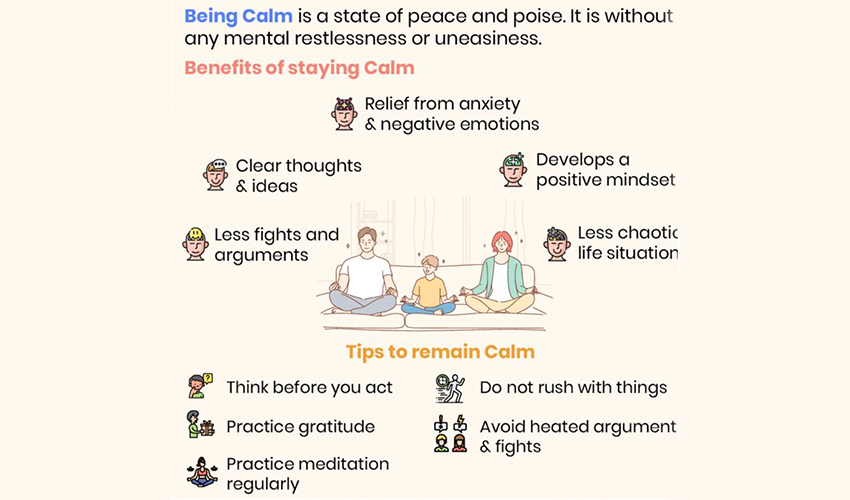In today’s fast-paced world, the digital age has ushered in incredible advancements, the constant influx of information, social media updates and it has brought challenges for our mental well-being. The incessant notifications, constant connectivity, and the pressure to keep up with the pace of online life contribute to a heightened state of restlessness.
Being mentally exhausted, feeling anxious, restlessness and struggling with overall mental health has always been a taboo topic and the feeling of restlessness arises through various internal as well as external factors and situations. It could be financial uncertainty, work stress, career, exams stress, issues related to family, partner and some people get anxious due to global issues too.
The fear of missing out (FOMO) and the comparison trap further fuel anxiety, making it difficult for individuals to find moments of tranquility where our minds are constantly bombarded with information and distractions, finding moments of peace and calm can seem like an impossible task. However, the practice of mindfulness offers a simple yet powerful solution to quiet the restless mind.

Let us first understand what the term Restlessness means:
Restlessness can manifest in various ways, both physically and mentally. It is a state of unease, agitation, or the inability to stay still or calm. It is a constant desire for change, activity, or stimulation, often accompanied by feelings of impatience or frustration.
Mentally, restlessness can manifest as racing thoughts, difficulty concentrating, or a general sense of dissatisfaction.
Physical Restlessness may involve fidgeting, pacing, or an inability to sit or stand still for an extended period. It’s important to note that restlessness is a subjective experience, and its intensity and causes can vary from person to person
The term “restless mind” aptly captures the constant churning of thoughts, worries, and distractions that characterize modern living.
In this blog, we’ll explore fun and easy exercises to help you cultivate mindfulness and calm your inner monkey – that ever-jumping, restless mind
Before starting with the exercises, it is important to note that the Restlessness can cause due to various factors which have been mention above but apart from that lifestyle also plays a major role such as, lack of physical activity, excessive caffeine intake, or disrupted sleep patterns, anxiety, boredom, or an underlying medical condition.
Being a psychologist, it is advisable to have a healthy lifestyle with a good diet, and a proper work-life balance in order to avoid the feeling of restlessness. In our app “LETS GET HAPPI”, we have some amazing features such as Journaling, self – assessment tests which will help you in understanding your mental health better. App also features some self-help tools which will help you to know yourself better and help you calm yourself. It also helps you to start your day with meditation videos and for improving your sleep cycles.

Here are some of the fun and easy activities you can try if you are feeling anxious or restless;
1. DIY Obstacle Course:
- Create a simple obstacle course using household items like cushions, chairs, or cones.
- Navigate through the course as quickly as possible.
2. Mindful Breathing:
- First sit or lie down comfortably.
- Try to focus on your breath, inhale and exhale slowly.
- Pay attention to the sensations of breathing, such as the rise and fall of the chest or the feeling of air passing through the nostrils.
- Do the same for 2/3 minutes until you feel calmer.
3. Visualization Exercises:
- Sit comfortably, try to look outside your window, focus and look for the things in the outer world.
- Use all of your senses, such as the sound of waves, the warmth of the sun, or the scent of flowers.
4. Grounding Technique:
- Sit on a chair, and prompt or write these following things withy names and description;
- 5 things you can see,
- 4 things you can touch,
- 3 things you can hear,
- 2 things you can smell,
- 1 thing you can taste.
- This technique will help you to bring attention to the present moment.
5. Creative Expression:
- Engage in creative activities like drawing, painting, writing, or crafting or any form of hobby you are interested in.
- Engaging in creative expression can serve as a form of self-expression and stress relief.
6. Sensory Activities:
- You can try Sensory-focused activities, such as squeezing a stress ball, playing with textured objects, or using aromatherapy with calming scents.
7. Nature Walk or Outdoor Activity:
- Spend your time in nature, whether it’s a short walk in a park, sitting by a river, or simply enjoying the outdoors.
- You can play your favorite sport too.
- Nature has a calming effect on the mind and body.
8. Yoga or Stretching:
- Learn some simple yoga poses or stretches to release physical tension and promote relaxation.
- You can find some great poses on our mental health app, Lets Get Happi.
- There are many beginner-friendly yoga routines available online.
9.Brain Teasers and Puzzles:
- Solve some puzzles, crosswords, or Sudoku to engage the mind and divert attention from restlessness.
Remember, every individual is different and some of these exercises might work for you and some of them might wont. But there is always a way to cater the issues. You can always opt for guidance from us by booking an appointment or use our features such as SOS CALL and SOS CHAT at Lets Get Happi.
Psychologists will always be available for you and we will tailor the exercises to each individual’s preferences and comfort levels. Remember, you are not alone and there is nothing wrong with you.
Mindfulness is a journey, and these exercises are just the beginning of cultivating a calm and centered mind. Consistent practice can lead to a more profound sense of well-being, improved emotional regulation, and enhanced overall mental health. So, the next time your inner monkey starts jumping around, take a moment to practice mindfulness.

